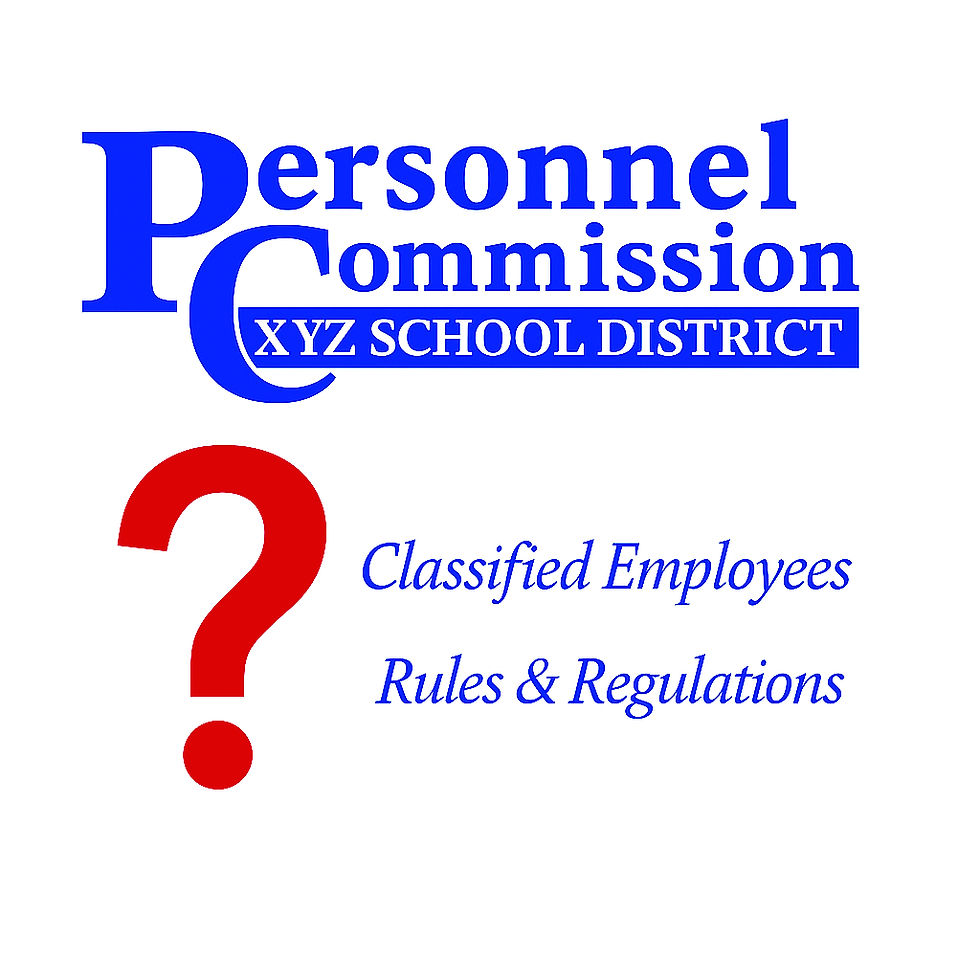Demystifying the Merit System for California School and District Leaders
- Ryan Smith

- Aug 2
- 6 min read
Updated: Sep 3

If you’re stepping into a leadership role in a California merit system district, you may quickly discover that hiring and personnel decisions for classified staff work differently than you might expect.
Consider this common scenario:
A school principal has a vacancy for a secretary. They know exactly who they want—someone they’ve worked with before who’s dependable, competent, and already supporting the school in another role. But in a merit system district, hiring doesn’t work that way. Instead of selecting the person directly, the principal must wait for a competitive examination process to generate an eligibility list. They may only choose from among the top three ranks of qualified candidates. Their preferred candidate might not be on the list at all.
This surprises many leaders who are new to the system. But it reflects the core principle behind merit-based employment: hiring and promotion decisions for classified employees must be based on qualifications, not connections.
I’ve served in several merit system districts across California, including my current role as Deputy Superintendent in the Bellflower Unified School District, as Superintendent of Schools in the Monrovia Unified School District, and as Principal at Leuzinger High School in the Centinela Valley Union High School District. This article is meant to demystify how the merit system works, why it exists, and what every school and district leader needs to know to work effectively within it.
Understanding the Merit System in California School Districts
The merit system is a civil service structure established to ensure fairness, transparency, and objectivity in personnel decisions for classified (non-certificated) employees. Its roots trace back to 19th-century civil service reforms designed to eliminate patronage in government hiring.
In California, the merit system was first applied to school districts in 1936 when Los Angeles Unified adopted it following a high-profile scandal in which hundreds of employees were dismissed after a school board election to make room for political appointments.
Employment decisions, whether hiring, promotion, or discipline, must be based on what a person knows and can do, not who they know.
California Education Code §§45240–45320 outlines the framework for school districts that operate under this model. Nearly 100 districts across California have adopted the merit system, most of which are K–12 school districts, along with some county offices of education and community college districts. Most school and district administrators have never worked in a merit district, and navigating this system can feel unfamiliar at first.
Core Elements of a Merit System
These are the foundational components that make a merit district function differently:
Personnel Commission
A three-member body governs the system, with one member appointed by the board, one by classified employees, and one jointly. The Commission operates independently of district administration and is charged with upholding the principles of merit-based employment (Ed Code §45260).
Personnel Director
The Commission appoints its own director (Ed Code §45264) to oversee classification, recruitment, testing, and eligibility list processes. While the Personnel Director often collaborates with district HR, they do not report to the superintendent or cabinet.
Commission Budget
The Personnel Commission develops and adopts its own annual budget, which the district is required to fund. The school board does not have authority to revise it (Ed Code §45253).
Eligibility Lists and Competitive Examinations
Hiring and promotion are based on examination results. Candidates are placed on an eligibility list, and only those in the top three ranks can be considered for appointment (Ed Code §§45272–45277). This process protects against favoritism and ensures fairness.
Probationary Period
All classified employees in California now serve a probationary period of six months or 130 days of paid service, whichever is longer, regardless of whether the district is merit or non-merit (Ed Code §45301; AB 1353). The only exception is that a Personnel Commission in a merit district may extend probation up to one year for executive, administrative, or police classes.
Reclassification and Job Classification Oversight
Districts cannot change job duties, titles, or compensation for classified roles without a formal review and approval by the Commission. The Personnel Commission ensures that employees are working within their appropriate classifications (Ed Code §45256).
Layoff and Reemployment Rights
Merit system districts follow strict rules for layoffs and reemployment based on seniority within job classification (Ed Code §45308). These provisions help ensure that reductions in force and subsequent rehires are handled fairly and transparently, without favoritism.
Due Process Protections for Discipline
Classified employees with permanent status are entitled to due process before being suspended, demoted, or dismissed. Education Code §§45302–45307 require written notice, an opportunity to respond, and a hearing before the Personnel Commission or a hearing officer. These protections are central to the merit system’s focus on fairness and transparency.
Understanding Personnel Commission Rules
Each merit district has a comprehensive set of Personnel Commission Rules. These are local policies developed and adopted by the Commission to implement the Education Code. Once adopted under §45260, the rules have the force of law within the district and are legally binding.
Classification and salary placement
Recruitment, examinations, and eligibility lists
Hiring, promotion, and demotion
Layoff and reemployment procedures
Disciplinary action and appeals
Commission Rules are not collectively bargained. While the classified bargaining unit (often CSEA) negotiates working conditions, the Rules govern much of the hiring, classification, and disciplinary processes.
Education Code §45261 clarifies how conflicts are handled: For topics that are mandatory subjects of bargaining under the Educational Employment Relations Act (EERA) and covered in a collective bargaining agreement, the rules for that bargaining unit must align with the negotiated agreement. For matters outside the scope of bargaining, the Commission Rules apply.
What Every Leader Should Keep in Mind
Working in a merit district requires a different mindset. Here are some of the most important things school and district leaders need to understand:
The hiring process takes more time. You can’t simply hire who you want when you want. The Commission must recruit, test, and establish an eligibility list before candidates can be considered—and that process doesn’t begin until a requisition is filed.
You can’t bypass the rules. Even with the best of intentions, the law and Commission Rules govern hiring, reclassification, and discipline. Skipping a step, offering a role informally, or assuming authority you don’t have can cause real legal issues.
Preferred candidates may not be eligible. If your ideal candidate doesn’t rank among the top three on the eligibility list, you can’t hire them. This is intentional—it ensures selections are based on demonstrated qualifications, not personal preferences.
Job descriptions and classifications are not easily changed. If you want to reorganize support roles, change hours, or adjust responsibilities, the changes must align with the official job classification and be reviewed through a formal process.
Merit System Personnel Directors have a unique role. They’re appointed by the independent Personnel Commission, not the superintendent or board, and must remain impartial in merit system matters. At the same time, they play a key role in supporting district operations and should work collaboratively with leadership to meet student and organizational needs.
HR responsibilities are shared. While the Personnel Commission manages recruitment, examinations, and classification, district HR still has significant responsibilities for classified employees. Onboarding, personnel records, investigations, labor relations, and evaluation coordination remain district functions. The Personnel Commission’s rules set the framework, and the district works within that structure to meet its HR responsibilities in collaboration with the Commission. Strong collaboration between the Personnel Commission and district HR is essential to ensure processes run smoothly and employees are supported effectively.
Leadership in a Merit System
You don’t need to be a merit system expert to lead well in a merit district, but you do need to understand how the system shapes your work. Hiring, reclassifying, promoting, or disciplining a classified employee will look different here than in most districts.
That’s not a bad thing. It just requires a shift in mindset and approach.
Work closely with your HR team and your Personnel Director. Before taking action, whether you are seeking to fill a vacancy, considering changes to a classified employee’s duties, or initiating a disciplinary process, take time to understand the required steps. Ask questions early. Merit system processes may be more structured than what you’re used to, and it is essential to clarify what is allowed and what is required.
It’s a different system, but once you understand it, the merit system can serve as a strong framework for fairness, professionalism, and human resources leadership.
Dr. Ryan Smith, with more than 20 years of leadership experience in public education, is dedicated to ensuring every student receives an outstanding education and reaches their highest potential. Through his current service as Deputy Superintendent in the Bellflower Unified School District and previous experience as Superintendent of the Monrovia Unified School District, his commitment to putting students first has driven success and positive change across various schools and districts. Learn more about Dr. Smith at his website, on LinkedIn, or X.





